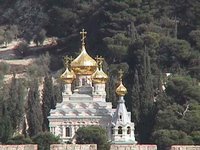
What I Saw In The Holy Land, 14
By far the most moving site on the Mount of Olives is Gethsemane, which is about halfway up the mountain. However, I'm going to "take" you to the points of interest starting at the peak and descending the Western slope. Above is the grotto of the Church of Pater Noster. This little chapel is built in the spot where Christ is said to have taught the disciples the Our Father. A Carmelite convent is here (a church is in the works, but lacks funds for completion at present), and all along the walls of the cloister are the words of the "Our Father" in every imaginable language --including Cherokee! If you've ever visited the Franciscan monastery in DC, you already know what the plaques look like. See what I mean about the extraordinary number of sites from Christ's life that are preserved? It's beautiful to think of Jesus & the disciples gathered together in a quiet cave somewhere, perhaps taking a meal, and the question of prayer coming up in conversation.
Anywhere you stop on the Western slope of the Mount of Olives, you'll have a breathtaking view of the Old City of Jerusalem. From the Pater Noster church, you can walk in steep descent past a Jewish cemetery. Jews, Muslims and Christians all like to be buried on the Western slope facing Jerusalem, so there are three cemeteries on Mt. Zion. The day we were there, a Jewish funeral was taking place, and the mourners were accompanied by armed police.
About half-way down the mountain, with the Jewish cemetery on your left, is the entrance to the grounds of Dominus Flevit, or the Church of "Jesus Wept." It's a tiny chapel, actually, constructed to look like a teardrop, and commemorating Christ's weeping over the impending destruction of Jerusalem in Luke 19. This photo is taken in front of the altar, and you can see Jerusalem in the background, although this shot doesn't do the view justice --it's really spectacular.
Standing on the path just on the other side of the glass here, you'd turn left to leave the grounds and then right to get back on the winding road and continue descending. You really need your walking shoes here; although the road is paved, it's quite steep. The walls along the path are interesting; they have large shards of glass sticking out of the top --just broken bottles of various colors. I asked our guide about them, and he said they're to keep people from climbing the walls of the various churches and cemeteries. Sounds barbaric, I know, but honestly, it looks much prettier than barbed wire. Very clever.
 You'll walk past the Russian Orthodox church of Mary Magdalene. I'm not intentionally short-changing the orthodox sites, but they tend to have restricted visiting hours. Say, Tuesdays from 10-noon. So they are often much more difficult to see. The Russians venerate the stone where Mary Magdalene saw St. Stephen martyred inside this church.
You'll walk past the Russian Orthodox church of Mary Magdalene. I'm not intentionally short-changing the orthodox sites, but they tend to have restricted visiting hours. Say, Tuesdays from 10-noon. So they are often much more difficult to see. The Russians venerate the stone where Mary Magdalene saw St. Stephen martyred inside this church. Next stop, Gethsemane.


